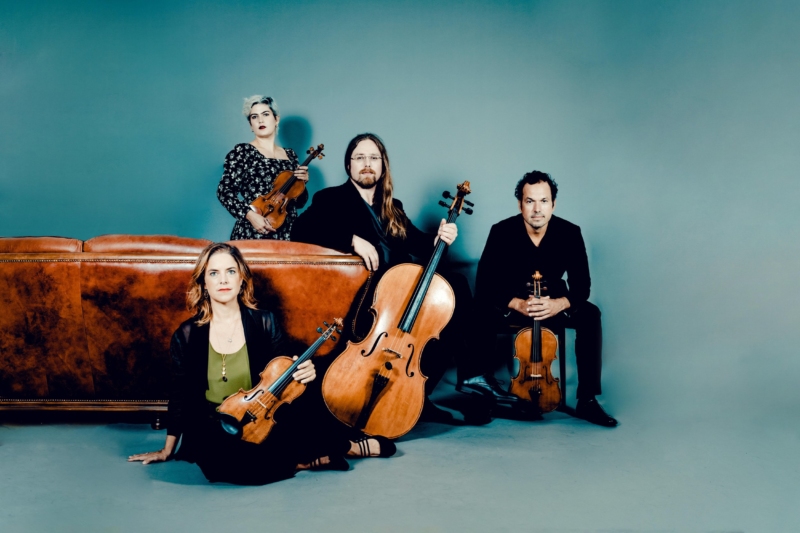READER: PLAYING WITH SEEDS
14.08.2023

George Lewis: String Quartet 2.5 “Playing with Seeds” (2017) – 20′
Sivan Eldar: Solicitations (2018) – 12′
Dai Fujikura: String Quartet No. 3 “Aquarius” (2020) – 10′
Alvin Singleton: String Quartet No. 2 “Secret Desire to Be Black” (1988) – 12′
Mark Andre: Sieben Stücke für Streichquartett (2022) – 6′
Mivos Quartet:
Olivia De Prato (Violin)
Maya Bennardo (Violin)
Victor Lowrie Tafoya (Viola)
Tyler J. Borden (Violoncello)
With the friendly support of the Ernst von Siemens Music Foundation and the Pro Musica Viva – Maria Strecker-Daelen-Stiftung (PMV)

OLIVIA DE PRATO AND MAYA BENNARDO ON PLAYING WITH SEEDS
Olivia De Prato: The program is exploring different sound worlds. I think it’s pushing the extremes of the instruments too. From very, very loud and extreme intense to the quietest sounds a string instrument can make – pushing the limits. Especially, when you go from the top of the program to the end.
Maya Bennardo: George Lewis’ piece even contains the entire program in it. Starting from there, we go off in different directions.
De Prato: The whole program is introducing the variety of the instruments and the group‘s ambiguity – also regarding the playing techniques, with extreme differences: there’s a scordatura, very quiet playing, mutes.
Bennardo: Especially Sivan Eldar and Mark Andre are exploring the edge of falling apart, where sound is no longer stable anymore.
De Prato: Lewis’ composition is a piece that we wanted to do in Darm-
stadt, because we‘ve doing it for several years now, and it’s one of our favourite pieces in our repertoire. In fact, it’s written for Mivos Quartet.
Bennardo: In contrast to it, the works by Sivan Eldar, Alvin Singleton and Mark Andre are new pieces for us.
De Prato: And apart from the fantastic sound worlds, we wanted to play this program knowing that most of the composers would be present in Darmstadt this year.
Olivia De PratoWe love playing together, we love playing contemporary music and doing a lot of collaborations. For us, one of the main missions is also not just performing new works and commissioning, but also doing a lot of collaborative works with artists from different backgrounds and different aesthetics. So, we work with a lot of people, a lot of composers and artists, musicians that come more from the improvised worlds, maybe more from the so-called jazz world, although, you know, we're all kind of together in this new music world.
Full conversation between Mivos Quartet and Spółdzielnia Muzyczna (S. 56)
STRING QUARTET 2.5 “PLAYING WITH SEEDS”
The anthropologist Paul Richards has spent over thirty years studying rice cultivation via shifting cultivation among the Mende-speaking population of the village of Mogbuama in Sierra Leone. Richards understands shifting cultivation as a system of improvisation that requires not only experience and intuition, but also knowledge of landscape, soil, weather and at least 45 different rice varieties. Richards likens this form of improvisation to the musical, while also pointing out the difference between the safety net of the structured art performance context and a real-time, real-world practice in which false moves can result in hunger, debt, starvation and death.
In this society, women are the principal investigators: cataloguing plant varietals, introducing new growing techniques, predicting and monitoring their impact on the environment, coping with contingencies and serving as repositories of memory for outcomes. Seed experimentation by women on small plots – “playing with seeds” – has resulted in the emergence of new and hardier varieties of rice, and it is this practice that offers an analogy for how this string quartet operates. The music is “grown” from “seeds” that are developed into new “varietals” through trajectories of register, temporal flux (stretching/compressing), sudden reversals of apparent fortune and the nomadism that is central to shifting cultivation.
I want to suggest that like all listening, an engagement with this work constitutes a form of nomadic improvisation – not by the performers, who are dealing with fully notated music – but on the part of audiences. In Mogbuaman society, farming sites belong to “the living, the dead and the yet unborn”. That’s actually quite a fine situation for a piece of music.
George Lewis
See: Paul Richards, “Shifting Cultivation as Improvisation”, in: “The Oxford Handbook of Critical Improvisation Studies”, Volume 1, edited by George E. Lewis and Benjamin Piekut, New York: Oxford University Press 2016, pp. 365-382.

SOLICITATIONS
“Solicitations”: songs, cries, whispers is a series of musical invitations that explore boundaries as offerings. Through solos, duos, trios, and quartets the ensemble exchanges words as gestures, which hang at the edge of comprehension as touch. Building on my trio “any bed but one‘s”, it draws inspiration from Fiona Sampson’s haptic poem “Drowned Man”:
See how they sleep first he turns
away and then she turns
after him or now she turns
her back and he follows
rolled by an imperative
deeper than sleep
he rolls over like a wave
that turns itself over
sleepily with the sea’s deep
breathing with its rhythm
pulsing far out from land pulsing far
down in the dark
where creatures not yet formed are forming
where like half made beasts
his dreams swim among hers where
she hears his breathing far
above her nearer to the light
nearer to the white-topped
waves the white-peaked sheets his arm
thrown across her now
as she floats upward drawing him
out of deep tides crossing
their legs once more and morning lies
motionless to the horizon.
Sivan Eldar

STRING QUARTET NO. 3: AQUARIUS
I always thought of a group of string instruments as more than just collection of solo string instrument. When they play together, the sound becomes another completely different living organism, like another instrument.
The sound of a group of strings – including the string quartet – has an elasticity. In my opinion it is the only combination that continually allows you to form one shape into another, in a sort of shape-shifting sort of way.
And it is not only the shape. While listening to such sound, I start to imagine what it is like to touch, squeeze, or eat the sound. Is it hard on the outside but soft on the inside, or other way around? How does it taste?
I wanted to construct a piece which freely changes form without any gaps or having a discernible feeling of sections. Before you realise it, the string quartet is making a sound quite different to what it was playing a moment ago.
Since I imagined a sort of floating, liquid form, I thought Aquarius was the perfect title. Coincidentally I found out as I completed the piece, that we were just about to enter (or had just entered) the 2000-year long Age of Aquarius.
I had no previous idea about – nor am I particularly interested in – the astrological ages, but with the timing of it all, I couldn’t help but name the piece “Aquarius”.
Dai Fujikura (edited by Alison Phillips)
STRING QUARTET NO. 2 “SECRET DESIRE TO BE BLACK”
It was not until 1988, deep into the Civil Rights struggle, that Singleton composed his second quartet, “Secret Desire to Be Black”, a work commissioned for and premiered by the Kronos Quartet. The Singleton habit of drawing the listener in is here already on display in its title. Before the very first note, the listener is scratching his or her head about it and is therefore engaged in the piece. The work opens adagio, with the cello locked into what feels like a shifting, basso continuo-like obbligato line, as the violins rise to excited twittering and the viola adds a constant chuffing. The work adds these motives slightly altered again and again, the first violin part evolving into a little dolce repeated line. These many repetitions seem to have the effect of a sonic mirage on the listener. Finally, this first two-thirds of the piece draws to a close as the cello rolls on and is at last drawn into the melee which explodes into one gritty chord. Might this be a form of resistance—standing up by standing out? Soon the piece seems to seek resolution from the long stretch of intensity in a more mellow closing.

SIEBEN STÜCKE FÜR STREICHQUARTETT
The “Seven Pieces for String Quartet” let us experience the sonic-temporal phenomenon as an “eidetic reduction” (Husserl) of the most unstable, intense, compositional interstices. It affects all unfolding, revealed, compositional sound signatures of the vanished action-sound-time categories and levels. The formal design is the eidetic, phenomenological extension of it. The signature “also preserves its being-present in a past now that will remain a future now” (Jacques Derrida: “Writing and Difference”).
Ultimately, it is a matter of “showing oneself to oneself” (Martin Heidegger. “Being and Time”).
The unfolded, compositional disappearance belongs to the very central categories of the Gospel and to many pericopes, such as the Last Supper at Emmaus, Luke 24 and 30-31).
The “Seven Pieces for String Quartet” are dedicated to the Kuss Quartet.
Mark Andre

